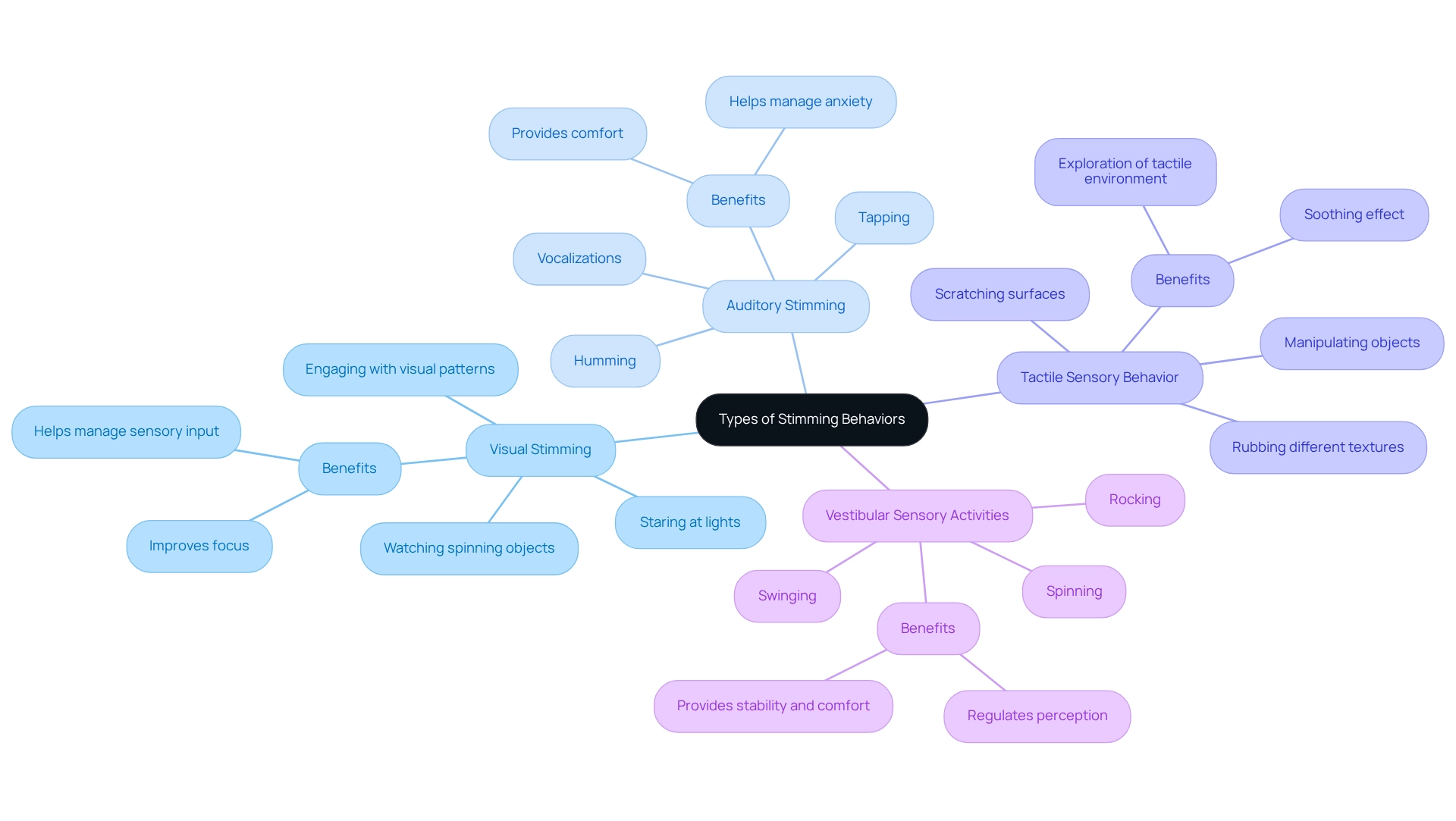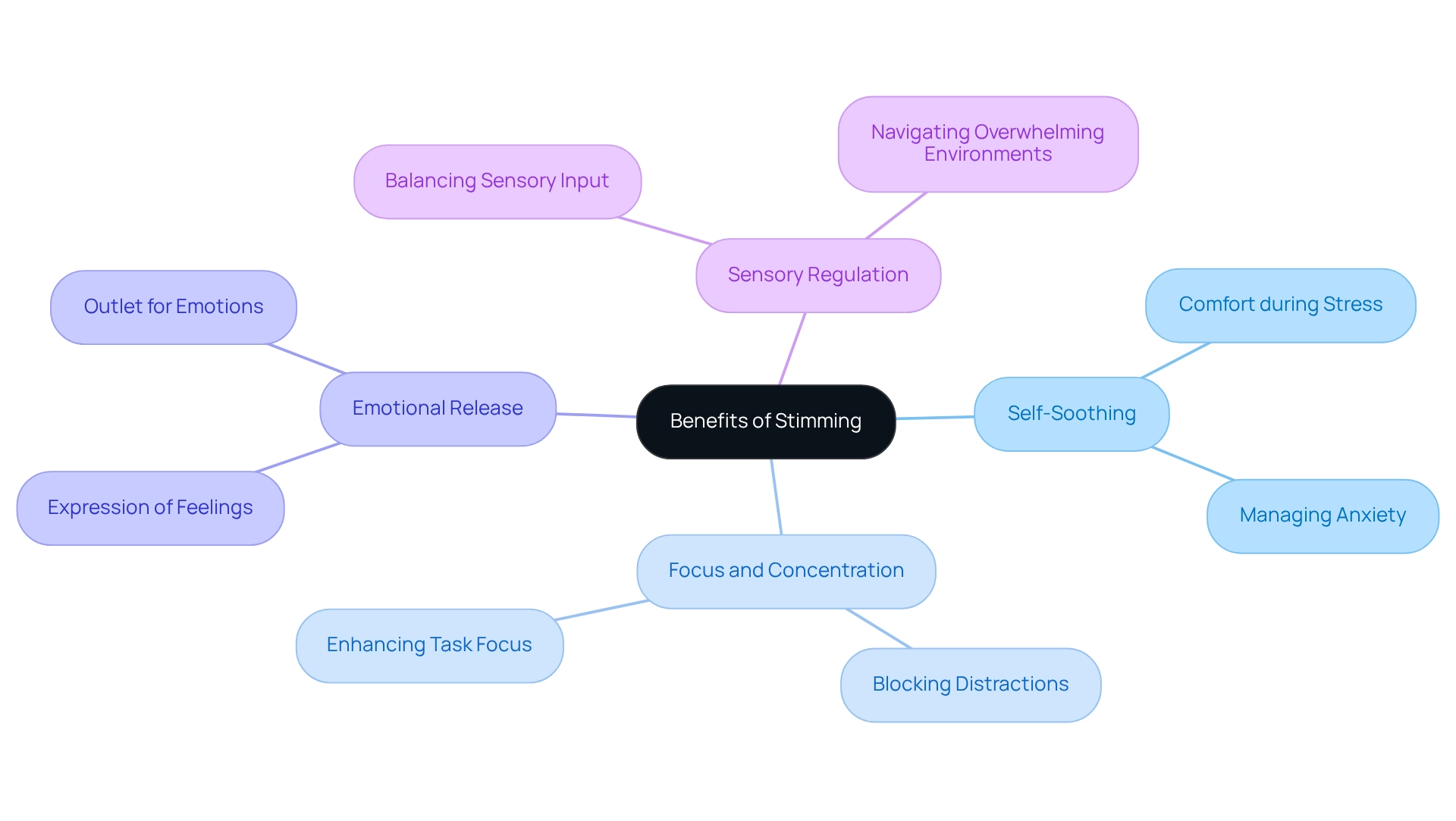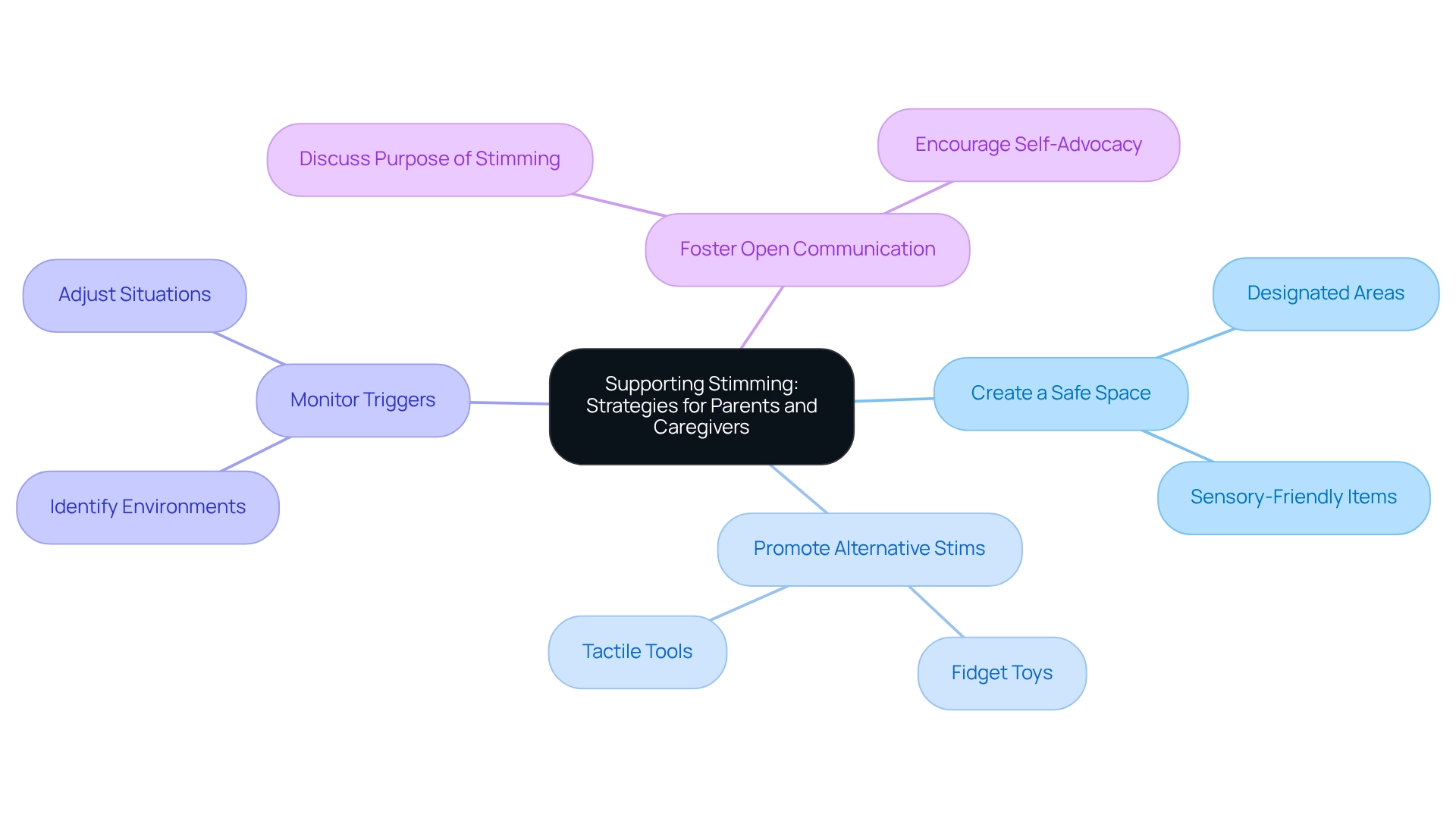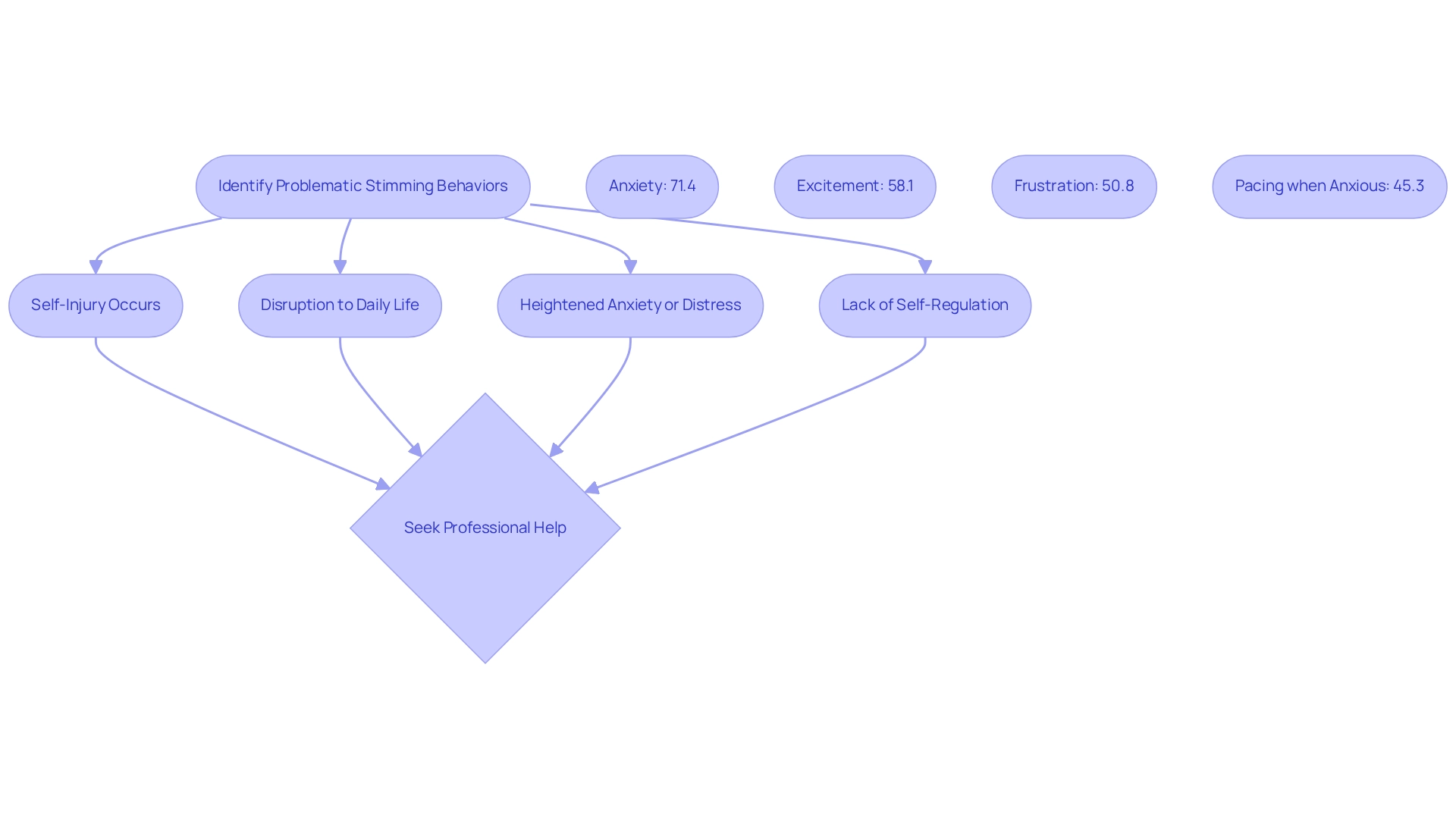Overview
This article delves into the important topic of autism self-stimming, highlighting its role as a vital coping mechanism for individuals with autism. By aiding in sensory and emotional regulation, stimming behaviors serve a significant purpose in the lives of those affected. We will explore the various types of stimming, their intended functions, and the crucial need for creating an accepting environment that embraces these behaviors.
As we navigate this subject, it's essential to recognize the challenges that parents and caregivers face. Understanding stimming can empower you to better support your autistic loved ones. Imagine the peace of mind that comes from knowing how these behaviors can help your child manage their emotions and sensory experiences.
Creating a nurturing atmosphere where stimming is accepted can make a world of difference. By fostering acceptance, you not only validate your child's experiences but also strengthen your bond with them. We encourage you to share your thoughts and experiences in the comments or through our newsletter, as your insights can provide valuable support to others in similar situations. Together, we can cultivate a community of understanding and compassion.
Introduction
In the realm of autism, stimming—short for self-stimulatory behavior—serves as a vital expression of individuality and a crucial coping mechanism for many. These repetitive movements and sounds, such as hand-flapping or rocking, are not mere quirks; they play a significant role in sensory regulation, emotional balance, and self-expression.
As awareness of autism grows, understanding the nuances of stimming becomes essential for parents and caregivers who strive to create supportive environments that honor these behaviors. By exploring the various forms and functions of stimming, along with its connection to sensory processing, this article delves into the importance of recognizing and embracing stimming as a natural part of the autistic experience.
Together, we can foster a deeper understanding and appreciation for these behaviors, paving the way for more inclusive and compassionate approaches.
Defining Stimming: What It Means in the Context of Autism
Stimming, or autism self-stimming, encompasses a variety of repetitive movements or sounds that individuals with autism often display. Common self-stimulatory behaviors include hand-flapping, rocking, spinning, and various vocalizations. These actions serve vital purposes, such as self-soothing, sensory regulation, and emotional expression.
For parents and caregivers, grasping the nuances of autism self-stimming is crucial, as it is a natural and widespread behavior among those on the autism spectrum. Engaging in self-soothing behaviors can provide comfort and a sense of control, particularly in overwhelming situations.
Research shows that around 80% of children with autism are estimated to experience sensory processing disorder, underscoring the importance of creating sensory-friendly environments. A case study on environmental modifications illustrates how such changes can significantly reduce stress for both children and their families, promoting positive social interactions and improving daily functioning.
Statistics reveal that many individuals engage in repetitive behaviors when alone to avoid drawing negative attention, highlighting the importance of understanding and accepting these actions. As one individual poignantly expressed, "I felt angry that they’ve been told a thousand times why I do it, the reason behind it, that it’s not affecting anyone."
As we move into 2025, the understanding of autism self-stimming continues to develop, with expert opinions emphasizing its role in emotional regulation for autistic individuals. Recognizing autism self-stimming behavior not only assists children but also empowers parents and caregivers to cultivate a more inclusive and compassionate environment.
Moreover, recent reports indicate that autism prevalence rates differ among various racial groups, with 1 in 41 for white children, 1 in 34 for black children, and 1 in 32 for Hispanic children. This context is vital for comprehending the broader implications of autism and its effects on diverse communities. It is equally important to acknowledge the limitations in current research, including the lack of systematic data on participants' clinical functioning, which may affect the interpretation of self-stimulatory behaviors.
Why Do Individuals with Autism Engage in Stimming?
Individuals with autism often engage in stimming for several important reasons.
Sensory Regulation: Stimming is essential for managing overwhelming stimuli or under-stimulation. For many, repetitive actions or sounds provide vital feedback that helps achieve a more balanced perceptual state. Given that around 80% of children with autism face processing challenges, understanding autism self-stimming is crucial for effective support.
Emotional Regulation: Stimming acts as a coping mechanism for emotions like anxiety, excitement, or frustration. By participating in these actions, individuals can self-soothe and regain a sense of control during overwhelming moments. Research shows that sensory traits, including self-soothing behaviors, are closely tied to emotional responses, highlighting their importance in emotional regulation.
Self-Expression: For many individuals with autism, repetitive behaviors serve as a form of self-expression, particularly when verbal communication is challenging. These actions can convey emotions and responses that might otherwise remain unspoken, allowing individuals to share their inner experiences in a way that feels comfortable.
Understanding these motivations enables caregivers to provide better support during sensory episodes. By recognizing self-stimulatory behaviors as normal and beneficial, caregivers can create an environment that respects these needs while also promoting effective communication and emotional well-being.
Moreover, the inclusion of processing differences in the DSM-5 diagnostic criteria underscores the importance of understanding autism self-stimming in relation to autism.
A USC-led study emphasizes that perceptual patterns can serve as early indicators for autism. The findings revealed that 3% of children exhibited an 'Elevated—All Worsening' trajectory of perceptual characteristics, leading to an autism diagnosis by ages 3-6. This underscores the vital role of perceptual experiences in understanding and supporting individuals with autism.
Exploring the Different Types of Stimming Behaviors
Stimming behaviors, or self-stimulatory actions, play a crucial role in addressing sensory needs, and they can be categorized into four primary types:
- Visual Stimming: This includes behaviors like staring at lights, watching spinning objects, or engaging with visual patterns. Such actions can assist individuals with autism in managing sensory input and improving focus. Notably, research from the case study titled 'Visual Perception and Processing in ASD' indicates that individuals with autism often exhibit a detail-oriented processing style, which enhances their engagement with visual stimuli.
- Auditory Stimming: This encompasses repetitive sounds, such as humming, vocalizations, or tapping. These auditory behaviors can provide comfort and help manage anxiety, enabling individuals to self-soothe in overwhelming environments.
- Tactile Sensory Behavior: Engaging with various textures is a hallmark of tactile sensory behavior. This may involve rubbing, scratching, or manipulating different surfaces, which can be soothing and assist individuals in exploring their tactile environment.
- Vestibular Sensory Activities: Movements that influence balance, like rocking, spinning, or swinging, fall under vestibular sensory activities. These actions can be particularly beneficial for regulating perception, offering a sense of stability and comfort.
Understanding these forms of autism self-stimming actions is essential for caregivers, as it empowers them to enhance support for individuals with autism. Studies reveal that around 75% of people with autism spectrum disorder (ASD) also contend with additional conditions like ADHD and anxiety, which can further impact their perception and repetitive actions. For instance, anxiety may lead to increased self-soothing behaviors as a coping strategy in stressful situations.
Recent research highlights the effectiveness of various actions related to autism self-stimming in managing sensory input, underscoring their importance in helping children cope with overwhelming stimuli. Fidget toys, for example, have been shown to enhance concentration and alleviate anxiety, making them valuable tools for children with special requirements. These toys provide a tactile outlet that aids children in self-regulating during challenging moments.
As Sarah Deweerdt wisely noted, "It may simply be that it is society, and not autistic people, who must change." By recognizing and encouraging these behaviors, caregivers can foster a more inclusive atmosphere that honors the unique perceptual characteristics of individuals with autism.

The Role of Sensory Processing in Stimming
Sensory processing encompasses how individuals perceive and respond to stimuli in their environment. For many people with autism, processing challenges can lead to feelings of overwhelm, making it difficult to navigate daily surroundings. In response to these perceptual hurdles, autism self-stimming—repetitive movements or sounds—becomes a vital coping mechanism.
Consider a child who rocks back and forth or flaps their hands to self-soothe when faced with overwhelming noise or crowded spaces. This behavior is not random; it serves an essential function in helping individuals with autism manage excessive stimulation.
Research shows that perception processing issues significantly affect behavior in autistic individuals. Studies indicate that these difficulties can heighten anxiety and lead to maladaptive behaviors. A noteworthy study involved 41 individuals with ADHD and 43 typical participants, underscoring the prevalence of processing challenges across these groups. Additionally, a case study on socially assistive robotics (SARs) reveals their potential in enhancing social skills among children with autism, particularly in areas where they typically struggle.
This highlights that interventions targeting sensory functions can also improve overall behavioral outcomes. By understanding the relationship between processing challenges and autism self-stimming, caregivers can create more supportive environments tailored to their children's needs. This approach not only fosters comfort but also encourages positive engagement with the world around them.
As awareness of sensory processing disorders (SPD) expands, collaboration among professionals becomes essential to enhance treatment options and resources for affected families. As noted by Alaa Salah, "The authors declare that they have no competing interests," which emphasizes the importance of unbiased research in this field. Ensuring that children receive the support they need to thrive also calls for increased funding and resources to assist affected families. Together, we can create a nurturing environment that empowers children with autism and their families.
Stimming as a Tool for Emotional Regulation
Stimming, often referred to as autism self-stimming, is a vital aspect of emotional regulation for individuals with autism. It serves as an essential outlet during intense emotions like excitement, anxiety, or frustration. For instance, a child may flap their hands joyfully or hum softly when feeling anxious. These self-stimulatory actions not only help in self-soothing but also play a significant role in restoring emotional balance.
Recent studies reveal that many autistic individuals experience positive outcomes from autism self-stimming, challenging the misconception that these behaviors are inherently harmful. In fact, some participants have learned to consciously use self-soothing behaviors as a strategy to prevent emotional dysregulation, showcasing its effectiveness as a coping mechanism for anxiety.
Anthony, who grew up in an autism-friendly environment, shared that he was never discouraged from engaging in self-stimulatory actions, highlighting the positive impact of acceptance on these behaviors. Conversely, case studies indicate that when autistic individuals feel pressured to hide their self-soothing actions due to negative social perceptions, it can lead to emotional distress and exhaustion. Rebecca voiced her frustration, expressing, "I’m angry that they’ve been told a thousand times why I do it, the reason behind it, that it’s not affecting anyone."
This emotional burden underscores the importance of societal acceptance, which can alleviate the pressures faced by autistic individuals, allowing them to engage in self-soothing behaviors without fear of judgment. Furthermore, a study examining the connection between sensory sensitivities and self-soothing actions reveals that autistic adults report both positive effects of self-soothing and negative impacts from societal pressure to conceal it.
By recognizing autism self-stimming as a beneficial coping method, caregivers can better support their loved ones, fostering an environment where these practices are embraced and understood as crucial resources for managing intense emotions. Ultimately, embracing autism self-stimming can empower individuals with autism to navigate their emotional landscapes more effectively.
The Benefits of Stimming: Understanding Its Positive Aspects
Stimming, or self-stimulatory behavior, offers a range of significant benefits for individuals with autism, which can be understood in several key areas.
- Self-Soothing: For many, stimming serves as a vital source of comfort during stressful moments, helping to manage anxiety and maintain emotional equilibrium.
- Focus and Concentration: Engaging in stimming can enhance concentration by providing a means to block out distractions, allowing individuals to better focus on their tasks.
- Emotional Release: These behaviors facilitate the expression of feelings that may be challenging to articulate verbally, providing an essential outlet for emotions.
- Sensory Regulation: Stimming helps in regulating sensory input, leading to a more balanced state and assisting individuals in navigating overwhelming environments.
Research shows that self-stimming and other repetitive behaviors are prevalent among autistic adults, indicating that these traits persist into adulthood and warrant further exploration. A recent study underscored the strong links between sensory motor activities and sensory sensitivities, reinforcing the idea that self-stimming is not merely a childhood phenomenon but a lifelong aspect of the autistic experience. This highlights the importance of understanding self-soothing behaviors, particularly stimming, and advocating for support that promotes safe self-soothing methods while reducing stigma.
Moreover, the emotional relief provided by these actions can be profound. One individual shared how incorporating stimming into their daily routine helped avert panic attacks, illustrating the practical benefits of these behaviors in everyday life. Statistics reveal that self-stimming can positively affect focus and concentration, further affirming the notion that these practices deserve acceptance rather than suppression.
The acceptance of recent research findings as of November 20, 2024, emphasizes the ongoing significance of these insights. By acknowledging and promoting the positive aspects of self-stimming, caregivers can foster an environment that nurtures self-expression and emotional well-being, ultimately enhancing the quality of life for individuals with autism.
We invite you to share your experiences or thoughts in the comments below, as your insights can help create a supportive community for those navigating similar journeys.

Supporting Stimming: Strategies for Parents and Caregivers
Encouraging autism self-stimming actions in children requires a thoughtful approach from parents and caregivers. It's essential to create a nurturing environment that supports these behaviors while fostering understanding and acceptance.
- Create a Safe Space: Establish designated areas where children can engage in self-soothing behaviors without fear of judgment. These spaces should be comfortable and filled with sensory-friendly items, allowing for self-expression and emotional regulation.
- Promote Alternative Stims: Introduce fidget toys or tactile tools that can serve as appropriate outlets for repetitive movements. Research shows that providing these alternatives can help manage sensory needs associated with self-stimming while enhancing focus and engagement in other activities.
- Monitor Triggers: Pay close attention to the environments and situations that may lead to increased self-stimulatory behaviors. By identifying these triggers, caregivers can make necessary adjustments to alleviate anxiety and support self-stimming, creating a more accommodating atmosphere.
- Foster Open Communication: It's vital to encourage an environment of open dialogue about self-stimming. Discuss its purpose with the child, helping them understand their actions and promoting self-advocacy. This communication can boost their confidence and foster a sense of control over their behaviors.
These strategies not only honor the individual’s needs but also contribute to their emotional well-being. A case study titled 'The Function of Stimming' highlights that self-stimming serves as an adaptive mechanism for emotional regulation, underscoring the importance of understanding these practices for improved support. Focus groups conducted for this research lasted around 60 to 90 minutes with six participants each, emphasizing the depth of insight gathered on this topic.
As Rebecca poignantly expressed, "I'm angry that they’ve been told a thousand times why I do it, the reason behind it, that it’s not affecting anyone." This illustrates the emotional aspect of self-soothing behaviors and the critical need for comprehension from family and friends. By implementing these strategies, parents and caregivers can cultivate a nurturing environment that empowers children with autism to flourish.

When to Seek Help: Identifying Problematic Stimming Behaviors
While autism self-stimming is often a natural and beneficial practice for individuals with autism, there are circumstances where it can become problematic. Caregivers should consider seeking professional help if they observe certain signs.
- Self-Injury Occurs: Instances where self-soothing behaviors lead to physical harm, such as head-banging or biting, warrant immediate attention.
- Disruption to Daily Life: If self-soothing actions interfere with everyday tasks, social engagements, or educational settings, it may be time to seek assistance.
- Heightened Anxiety or Distress: When a person seems troubled or uneasy during self-stimulatory episodes, this can suggest that the action is not fulfilling its intended role of self-soothing.
- Lack of Self-Regulation: If a person has difficulty managing their repetitive actions in suitable environments, it may indicate a need for intervention.
Studies show that a considerable percentage of autistic individuals engage in self-soothing behaviors during heightened emotional states, such as anxiety (71.4%), excitement (58.1%), and frustration (50.8%). Furthermore, 45.3% of participants indicated pacing when feeling anxious, emphasizing the varied methods people may use to express their emotional states. This highlights the need for caregivers to comprehend the context of self-stimulatory behavior and its role in emotional regulation.
Additionally, research on masking actions reveals that many autistic individuals inhibit their self-soothing to meet societal norms, frequently resulting in heightened stress and potential mental health hazards. For instance, participants in these studies reported that while some found masking beneficial, many described it as exhausting and detrimental to their well-being. As one participant, Rose, noted, "it helps me keep me calm … it cuts down what is going on around, it helps me focus."
Identifying these signs enables caregivers to pursue professional advice and assistance, ensuring that the person can flourish while managing their self-soothing behaviors effectively. Understanding the role of stimming in the well-being of autistic individuals is crucial for fostering a supportive environment.

Conclusion
Stimming, or self-stimulatory behavior, is an inherent part of the autistic experience, serving as a crucial mechanism for sensory regulation, emotional balance, and self-expression. It is essential to recognize that stimming is not merely a collection of repetitive actions; rather, it is a vital coping strategy for many individuals with autism. By understanding the various forms of stimming—whether visual, auditory, tactile, or vestibular—caregivers can better support the sensory needs and emotional well-being of those they care for.
Moreover, the positive aspects of stimming cannot be overlooked. It plays a significant role in self-soothing, enhancing focus, releasing emotions, and managing sensory input. This understanding fosters an environment of acceptance, encouraging the creation of safe spaces where individuals can engage in stimming without fear of judgment. By implementing supportive strategies, such as providing sensory-friendly tools and maintaining open communication, caregivers can empower individuals with autism to thrive while embracing their unique behaviors.
While stimming can be beneficial, it is also vital to recognize when these behaviors may become problematic. Being aware of signs that indicate a need for professional support ensures that individuals can navigate their emotional landscapes effectively. Ultimately, fostering a compassionate understanding of stimming paves the way for a more inclusive society that values the diverse expressions of the autistic community. This approach leads to richer connections and improved quality of life for all.
Frequently Asked Questions
What is stimming in the context of autism?
Stimming, or autism self-stimming, refers to a variety of repetitive movements or sounds that individuals with autism often display. Common behaviors include hand-flapping, rocking, spinning, and various vocalizations.
Why do individuals with autism engage in stimming?
Individuals engage in stimming for several reasons, including sensory regulation, emotional regulation, and self-expression. These behaviors help manage overwhelming stimuli, cope with emotions, and communicate feelings when verbal communication is challenging.
How does stimming help with sensory regulation?
Stimming is essential for managing overwhelming stimuli or under-stimulation, providing vital feedback that helps individuals achieve a more balanced perceptual state.
In what ways does stimming assist with emotional regulation?
Stimming acts as a coping mechanism for emotions such as anxiety, excitement, or frustration, allowing individuals to self-soothe and regain a sense of control during overwhelming moments.
How does stimming serve as a form of self-expression?
For many individuals with autism, repetitive behaviors convey emotions and responses that might otherwise remain unspoken, allowing them to share their inner experiences in a comfortable manner.
What is the significance of understanding autism self-stimming for parents and caregivers?
Grasping the nuances of autism self-stimming is crucial for parents and caregivers, as it is a natural behavior that can provide comfort and a sense of control for individuals in overwhelming situations.
What percentage of children with autism are estimated to experience sensory processing disorder?
Research indicates that around 80% of children with autism are estimated to experience sensory processing disorder.
How can environmental modifications impact children with autism?
Environmental modifications can significantly reduce stress for children with autism and their families, promoting positive social interactions and improving daily functioning.
Are there any differences in autism prevalence rates among racial groups?
Yes, recent reports indicate that autism prevalence rates differ among racial groups: 1 in 41 for white children, 1 in 34 for black children, and 1 in 32 for Hispanic children.
What limitations exist in current research on autism self-stimming?
Current research has limitations, including a lack of systematic data on participants' clinical functioning, which may affect the interpretation of self-stimulatory behaviors.




